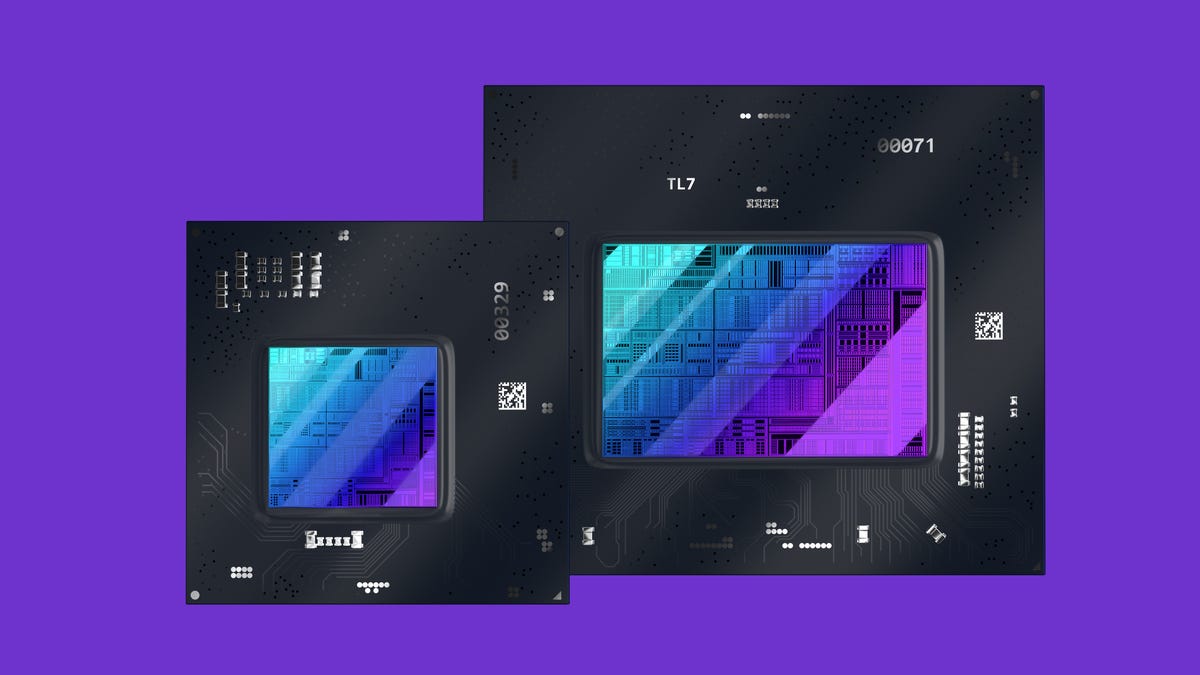Intel Arc Graphics Begin the Rollout, Starting at the Bottom
The company's long-awaited discrete graphics enter the world, starting with the A350M and A370M mobile GPU for thin and light laptops.

The Arc 3 compared to its bigger siblings.
Intel finally debuts its new discrete graphics cards, arriving more than fashionably late to a party already dominated by Nvidia and AMD. Based on the same Xe architecture that debuted in its integrated GPUs circa 2020 (11th-gen Tiger Lake), it expands the hardware and features to take advantage of access to the higher power and dedicated memory available when it's not sharing space with the CPU, an architecture Intel calls Xe HPG. The Arc 3 line gives a bump to gently push a laptop over the 60 frames per second hump for graphics-intensive games and to deliver improved performance for creative tasks, such as video encoding and AI-driven features.
Out now are the Arc 3 GPUs, the A350M (25-35 watts) and A370M (35-50 watts); starting in June the higher-end A550M (60-80 watts), A730M (80-120 watts) and A770M (120-150 watts) will start shipping in laptops. Intel also teased an upcoming desktop card, labeled "Limited Edition," in a brief clip at the end of its announcements. Earlier this year, the Samsung Galaxy Book 2 Pro was listed as the first to ship with all the Intel Evo bells and whistles, and it shipped today.
Notable technologies include XeSS, (Intel's AI-boosted upscaling for faster frame rates a la Nvidia DLSS and AMD FidelityFX Super Resolution), XMX matrix engine (to accelerate AI, like Nvidia's Tensor cores) and the Xe media engine (video encode and decode acceleration, including the first AV1 encoder accelerator in a GPU).
Intel Arc A series
| A350M | A370M | A550M | A730M | A770M | |
|---|---|---|---|---|---|
| Xe cores and ray-tracing units | 6 | 8 | 16 | 24 | 32 |
| Power range (watts) | 25-35 | 35-50 | 60-80 | 80-120 | 120-150 |
| Typical graphics clock speed (GHz) | 1.15 | 1.55 | 0.9 | 1.1 | 1.65 |
| Memory | 4GB GDDR6 | 4GB GDDR6 | 8GB GDDR6 | 12GB GDDR6 | 16GB GDDR6 |
| Memory bus | 64 bit | 64 bit | 128 bit | 192 bit | 256 bit |
Like AMD's RDNA 2 generation of GPUs, there's only a single ray-tracing unit per Xe core. I find that doesn't perform very well for AMD; let's see how it works for Intel, which is also heavily based around Windows DirectX 12 Ultimate.
Of course, there are more capabilities tied to systems with Intel's own CPU (which AMD does, too), using Intel's Deep Link technology. Dynamic Power Share allocates extra power to the CPU or GPU depending upon the workload in systems with 12th-gen Core CPUs, similarly to AMD SmartShift. HyperEncode basically pools all available encoding engines of both the CPU and GPU, portions out the video and then gathers up the results and feeds it back to your software in a stream as if it were performed by a single engine. And HyperCompute does essentially the same thing for compute engines and AI accelerators.
See also
As part of its Arc launch and in anticipation of the real gaming-focused mobile and desktop GPUs, Intel's rolling out a successor to its Graphics Command Center software, Arc Control. The new software handles the usual tasks we've seen in game command center software, including system monitoring and tweaking, automatic driver downloads, some streaming tools (including a Virtual Camera like Nvidia Broadcast and automatic game highlight capture. The company's also working on building out its community, with the usual giveaways, events, challenges and a dedicated Discord server.

